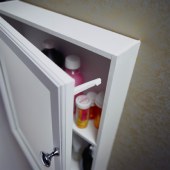
WEDNESDAY, Nov. 11 (HealthDay News) — Sharing prescription medication with a family member or friend who needs care may seem like the right thing to do, even an act of kindness. But new research highlights the potential hazards of passing these medicines around.
Of people who borrowed a medicine prescribed for someone else, 25.1 percent experienced some sort of side effect, researchers reported Wednesday at the American Public Health Association annual meeting in Philadelphia.
While 77.3 percent of prescription borrowers said they had bummed medicine rather than see a health-care provider, for many it merely delayed the inevitable. That’s because one in three ended up seeking medical care, anyway.
A lot of people have focused on “recreational medication sharing,” or abuse of prescription drugs “for a buzz,” explained lead investigator Richard C. Goldsworthy, director of research and development at The Academic Edge, a Bloomington, Ind.-based developer of educational media.
“What people haven’t looked at is what we started to call ‘altruistic medication sharing,'” he said. “It’s ‘You’re not feeling so well,’ and a friend happens to have some extra medicine of a certain kind that treats symptoms similar to what you’re having, and they let you borrow it.”
In an earlier study, Goldsworthy and colleagues reported that 20 percent of U.S. teens say they swap prescription drugs such as antibiotics and allergy medicines with friends. The new study corroborates the frequency of drug-sharing in America, with one in five admitting to borrowing drugs.
Many people just think it’s “no big deal,” he explained.
Yet depending on the drug, the dosage and other factors, it can be a very big deal, one expert cautioned.
“There’s always been an issue, especially with medications such as pain medications,” said Allen J. Vaida, executive vice president at the Institute for Safe Medication Practices (ISMP), in Horsham, Pa.
Painkillers come in different dosages and some combine, say, an opioid with acetaminophen (the active ingredient in Tylenol), he said. If the borrower is already taking an over-the-counter pain reliever, such as Tylenol, he or she could be doubling the dose of acetaminophen, Vaida said.
In one tragic case, a 6-year-old with neck pain was found unconscious in bed the day after her foster mother placed a leftover fentanyl patch on the girl’s neck, ISMP reported. The child died before reaching the emergency room.
But pain medications are not the sole cause of unintentional consequences. Sharing eye-drops can result in the spread of infection, Vaida noted. Doling out leftover antibiotics can result in unnecessary treatment or treatment with the wrong antibiotic, he said. And taking someone else’s anti-anxiety medicine without the proper warnings can cause unanticipated dizziness or sleepiness behind the wheel of a car.
A week ago, the U.S. Food and Drug Administration (FDA) launched a new campaign aimed at reducing “preventable harm” from medication use. Taking medication meant for other people is among the potential dangers it highlighted.
“Too many people suffer unnecessary injuries from avoidable medication misuse, errors, and other problems,” FDA Commissioner Dr. Margaret A. Hamburg said in a statement. FDA is launching the Safe Use Initiative to develop targeted solutions for reducing these injuries.
To find out whether drug sharing is putting people in harm’s way, Goldsworthy had trained field agents conduct one-on-one interviews of almost 2,800 people in 11 different markets.
Of those who admitted to borrowing prescription medicines, many never got written (54.6 percent) or verbal (38.2 percent) warnings or instructions from the person loaning the medicine.
Among people who delayed seeking care, half of them never told their health-care provider that they had taken a borrowed medication.
“On the side effects, we don’t actually know the severity. It’s actually a limitation of the study,” Goldsworthy said. “And we also don’t know, in the analysis we’ve done so far, how many of those are actually people who sought a side effect.”
Still, the prevalence of side effects suggests that the risk for harm is a real possibility.
Avoiding unintended health consequences begins with education, Vaida said. Physicians, pharmacists and nurses need to tell patients not to share their medicines with family or friends, he explained.
People should also get in the habit of cleaning out their medicine cabinets and turning over leftover and unused drugs to community “take-back” programs, he added.
“That’s probably something that should be done all the time in every community,” Vaida said.
More information
There’s more on preventing medication errors at the Institute for Safe Medication Practices.

